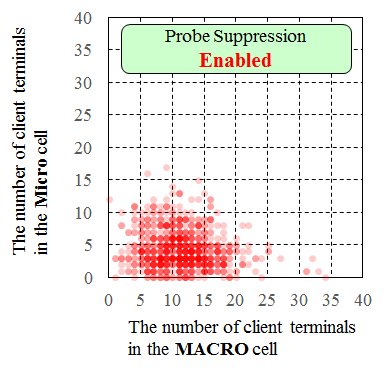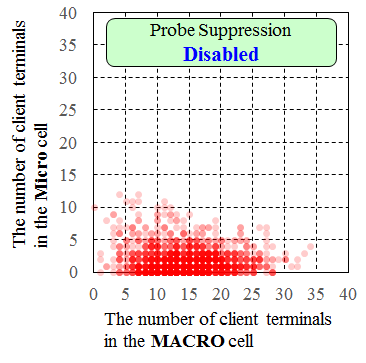- ナレッジセンター
- 匠コラム
The Effect of Enabled Probe Suppression in a MACRO/Micro Cell Architecture of Cisco AP3802I
- 匠コラム
- ネットワーク
Applied Technology Engineering Department1,
Business Development Division
Takashi Matsudo
We had an experimental study in our indoor office environment to confirm the effect of enabled Probe Suppression in a Micro cell on a MACRO cell architecture of Cisco AP3802I in dual 5GHz band operations. It was found that the enabled Probe Suppression makes the number of client terminals balanced between in the MACRO cell and in the Micro cell as adaptively as possible. Since it can be expected that the Micro cell on the MACRO cell architecture for Cisco AP3802I and AP2802I creates double the capacity within the boundaries of a single cell of a single AP, we should enable the function of Probe Suppression when we operate the Micro cell on MACRO cell architecture.
Note: The original in Japanese of this report was opened to the public in Feb.28, 2018[1] .
Introduction
Cisco AP3802I and AP2802I support a MACRO/Micro cell architecture in dual 5GHz band operations of a single AP. Since the MACRO/Micro cell architecture is a large cell with a smaller cell internal operated by the single AP, we can also call it “a Micro cell on a MACRO cell architecture”. It can be expected that the MACRO/Micro cell architecture creates double the capacity within the boundaries of a single cell of the single AP. In order to create double the capacity credibly, the number of client terminals associated with the single AP operated by dual 5GHz bands is required to have balance between in the MACRO cell and in the Micro cell.
When we read a document by Cisco[2],weunderstood that a function of enabled Probe Suppression might make the number ofclient terminals balanced between in the MACRO cell and in the Microcell.Therefore, we had an experimental study in our indoor officeenvironmenttoconfirm the effect of enabled Probe Suppression in the Micro cellon the MACROcellMACROcell architecture of Cisco AP3802I in dual 5GHz bandoperations.
Results
Our office’s wireless LAN has operated 10 AP3802Is for dual 5GHz bands and 12 AP3802Is for 2.4/5GHz bands in a floor area of approximately 2800 square meters.
Figure1 shows a situation of the number of client terminals between in the MACRO cell and in the Micro cell recorded by the 10 AP3802Is for dual 5GHz band operations in enabling Probe Suppression. In Figure1, the horizontal axis is the number of client terminals in the MACRO cell and the vertical axis is the number of client terminals in the Micro cell. In Figure1, Probe Suppression is enabled with an option for “Probe and Auth Suppresses“ and all of the MACRO/Micro transition thresholds are default settings that are highly recommended by Cisco[2].

Figure1
The number of client terminals each cell of the 10 AP3802Is was counted at both 11AM and 2PM on working days for three months.In the three months, the mean number of client terminals associated with 5GHz band on the floor area was 333.9 and the standard deviation of number of client terminals was 32.0.
Figure1 shows the results of 839 counting that are shown by the symbols of a red circle. The dark red circle means that it is more frequently.
The mean and the standard deviation calculated from data shown in Figure1 are as follows:
(1)The mean number of client terminals in the MACRO cell=11.3 ,
(2)The standard deviation of number of client terminals in the MACRO cell=4.6 ,
(3)The mean number of client terminals in the Micro cell=4.4 ,
(4)The standard deviation of number of client terminals in the Micro cell=2.9 .
On the other hand, in Figure2, Probe Suppression is disabled. A default setting for Probe Suppression is disabled by Cisco[2].Thedatashown in Figure2, which had been acquired earlier than the data shown inFigure1, had been recorded for five months. In disabling ProbeSuppression,ouroffice’s wireless LAN operated the 9 AP3802Is for dual 5GHz bandsand 13AP3802Is for 2.4/5GHz bands in the same floor area as it for Figure1.Figure2 shows thesituation of the number of client terminals between in theMACRO cell and in theMicro cell recorded by 9 AP3802Is for dual 5GHz bandoperations in disablingProbe Suppression. In Figure2, the horizontal axis is thenumber of client terminals in the MACRO cell and the vertical axis is the numberofclientterminals in the Micro cell.

Figure2
The number of client terminals each cell of the 9 AP3802Is was counted at both 11AM and 2PM on working days for five months. In the five months, the mean number of client terminals associated with 5GHz band on the floor area was 285.8 and the standard deviation of number of client terminals was 29.6.
Figure2 shows the results of 1575 counting that are shown by the symbols of the red circle. The dark red circle means that it is more frequently.
The mean and the standard deviation calculated from data shown in Figure2 are as follows:
(5)The mean number of client terminals in the MACRO cell=14.5 ,
(6)The standard deviation of number of client terminals in the MACRO cell=5.4 ,
(7)The mean number of client terminals in the Micro cell=1.9 ,
(8)The standard deviation of number of client terminals in the Micro cell=1.9 .
Discussion
It is considered that a selection of the AP or the cell with which client terminals associate depends on those specifications. Therefore, it is difficult for the AP or the cell to manage the client terminals load balancing accurately. However, as shown in Figure1 and Figure2, it is evident that the enabled Probe Suppression can promote to increase the number of client terminals in the Micro cell and to decrease the number of client terminals in the MACRO cell . It is likely that the enabled Probe Suppression makes the number of client terminals balanced between in the MACRO cell and in the Micro cell as adaptively as possible.
Conclusion
We figured out that the effect of the enabled Probe Suppression was great !
It is likely that the enabled Probe Suppression makes the number of client terminals balanced between in the MACRO cell and in the Micro cell as adaptively as possible. We should enable the function of Probe Suppression when we operate Cisco AP3802I and AP2802I with the Micro cell on MACRO cell architecture.
It is believed that the Micro cell on MACRO cell architecture operated by Cisco AP3802I and AP2802I is much better than the MACRO cell on MACRO cell architecture given by APs of other vendors. The antenna for Micro cell on Cisco AP3802I and AP2802I will be able to decrease a risk of interference using co-channel in both TX and RX.
It is considered that a new AP for the emerging IEEE 802.11ax standard[3],[4] will support more clients in dense environments and provide a better experience for typical wireless LAN networks. In the future, If Cisco’s new AP has the Micro cell on MACRO cell architecture in addition to new technologies of IEEE802.11ax, it will be able to provide the best experience that APs of other vendors will never be able to provide.
References
[1] Takashi Matsudo, Kiyotaka Nakano, ” Experiment to use wireless LAN well by dual 5GHz band operations even if there are many client terminals“, /knowledge-center/blog-column/knowledge_takumi_164/index.html, February 28, 2018 (in Japanese), (accessed 2018-12-26).
[2] Cisco systems, “Radio Resource Management White Paper, Chapter: Flexible Radio Assignment (FRA) and Redundant Radios, FRA and Dual 5 GHz Operations”,
https://www.cisco.com/c/en/us/td/docs/wireless/controller/technotes/8-3/b_RRM_White_Paper/b_RRM_White_Paper_chapter_01000.html#concept_5B842FD
7ACB745D68CA3D67F056D56C3F, June 24, 2016 (accessed 2018-12-26).
[3]Status of Project IEEE 802.11ax, “11-14-0165 Project Authorization Request (PAR)”, PAR Approval Date: 27-Mar-2014, http://grouper.ieee.org/groups/802/11/Reports/tgax_update.htm (accessed 2018-12-26).
[4] Cisco systems, “Technical white paper IEEE 802.11ax: The Sixth Generation of Wi-Fi”, https://www.cisco.com/c/dam/en/us/products/collateral/wireless/white-paper-c11-740788.pdf (accessed 2018-12-26).
About the author
Takashi Matsudo is a Senior Expert of a wireless LAN technology in Applied Technology Engineering Department at NetOneSystems Co., Ltd. and has evaluated Cisco’s wireless LAN products since 2001. His fields of expertise are a radio wave propagation and an antenna technology. He and his colleagues received awards four times (in 2013, 2014, 2015 and 2018) in Cisco Technology Contest held by Cisco Japan (Cisco Systems G.K.). He has a license of First-Class Technical Radio Operator.
Webからのお問い合わせはこちらから
ナレッジセンターを検索する
カテゴリーで検索
タグで検索

